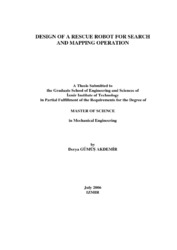Please use this identifier to cite or link to this item:
https://hdl.handle.net/11147/3867Full metadata record
| DC Field | Value | Language |
|---|---|---|
| dc.contributor.advisor | Keçeci, Emin Faruk | en |
| dc.contributor.author | Gümüş Akdemir, Derya | - |
| dc.date.accessioned | 2014-07-22T13:52:32Z | |
| dc.date.available | 2014-07-22T13:52:32Z | |
| dc.date.issued | 2006 | en |
| dc.identifier.uri | http://hdl.handle.net/11147/3867 | |
| dc.description | Thesis (Master)--Izmir Institute of Technology, Mechanical Engineering, Izmir, 2006 | en |
| dc.description | Includes bibliographical references (leaves: 65-66) | en |
| dc.description | Text in English; Abstract: Turkish and English | en |
| dc.description | x, 76 leaves | en |
| dc.description.abstract | The aim of this thesis is to design a mobile robot for rescue operations after an earthquake. The robot is designed to locate injured victims and life triangle in debris, to create a map of the disaster area and to collect the necessary information needed by digging and support robots in order to the database center. This robot enables us to rescue the victim in the shortest time with minimum injury. This will let us risking the lives of the rescue teams much less as well as rescuing much more victim alive.Robot is designed with the longitudinal body design. Shock absorber system gives the damper effect against falls as well as adding advanced equilibrium properties while passing through a rough land. Driving mechanism is a tracked steering system.Front and back arm system is developed to provide high mobility while overtaking the obstacles.Secondly hovercraft type robot, which works with the cushion pressure principle, is designed as a rescue robot. It is thought that if the adequate height is supplied, the robot could manage to overcome obstacles.As a third design, ball robot, which could easily move uphill and has a capability to overrun obstacles, is studied.Jumping mechanism will be working by magnetic piston.In addition robot is equipped with the sensors so that it has capable of the navigation. In order to achieve feasible sensor systems, all electronic components are evaluated and the most effective sensors are chosen. | en |
| dc.language.iso | en | en_US |
| dc.publisher | Izmir Institute of Technology | en |
| dc.publisher | Izmir Institute of Technology | en_US |
| dc.rights | info:eu-repo/semantics/openAccess | en_US |
| dc.subject.lcc | TJ211 .A31 2006 | en |
| dc.subject.lcsh | Robots--Design and construction | en |
| dc.subject.lcsh | Search and rescue operations | en |
| dc.subject.lcsh | Earthquakes | en |
| dc.title | Design of a rescue robot for search and mapping operation | en_US |
| dc.type | Master Thesis | en_US |
| dc.institutionauthor | Gümüş Akdemir, Derya | - |
| dc.department | Thesis (Master)--İzmir Institute of Technology, Mechanical Engineering | en_US |
| dc.relation.publicationcategory | Tez | en_US |
| item.languageiso639-1 | en | - |
| item.fulltext | With Fulltext | - |
| item.openairecristype | http://purl.org/coar/resource_type/c_18cf | - |
| item.openairetype | Master Thesis | - |
| item.grantfulltext | open | - |
| item.cerifentitytype | Publications | - |
| Appears in Collections: | Master Degree / Yüksek Lisans Tezleri | |
Files in This Item:
| File | Description | Size | Format | |
|---|---|---|---|---|
| T000546.pdf | MasterThesis | 1.07 MB | Adobe PDF |  View/Open |
CORE Recommender
Page view(s)
176
checked on Jul 22, 2024
Download(s)
130
checked on Jul 22, 2024
Google ScholarTM
Check
Items in GCRIS Repository are protected by copyright, with all rights reserved, unless otherwise indicated.